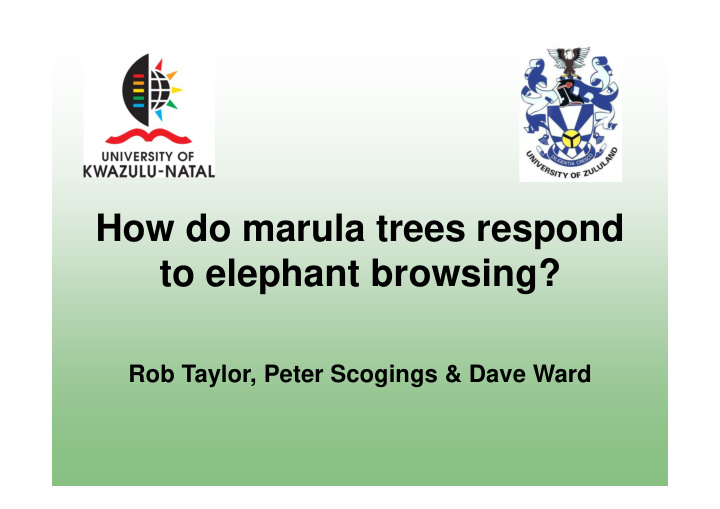



How do marula trees respond to elephant browsing? Rob Taylor, Peter Scogings & Dave Ward
Elephants • Important non-ruminants that consume woody plants in African savannas • Little is known of the plant-level responses to elephant damage • long-term sever browsing is reported to simulate the production of nutritious material • Positive feedback loop
Marula tree • Prominent savanna tree •Deciduous, dioecious, and has high tannin conc. in its’ bark and compound leaves • Favoured by elephants • Elephant damage affects tree growth and survival
How marula trees respond to elephant browsing is important for the sustainable management of both these iconic species and the savanna habitats in which they occur.
Aim To investigate the relationships between the intensity of browsing attributed to elephants and; • shoot length • leaf size • leaf chemistry • nitrogen • condensed tannin conc. at different canopy positions on male and female marula trees
Methods • 70 trees in Hluhluwe- iMfolozi Park • Control – Hilltop camp • All remaining trees at two nearby sites • High density of both marula trees and elephants
• Mature trees were sampled (mean height 7.5 m) • Elephants mostly forage below 5 m • % of the canopy below the browse line removed by elephants was recorded
• Tree height • Tree sex From below and above the browse line and from damaged and undamaged branches • Current season shoot growth • Leaf size • Tannin & nitrogen concentration
100 • Female trees had higher condensed tannins that -1 ) Condensed tannin conc. (mg ml male trees 10 • Condensed tannins decreased with and increase in browsing 1 Male Female intensity 5 4 • Above a browsing N concentration (%) 3 intensity of ~60% the 2 nitrogen conc. increased 1 0 20 40 60 80 100 120 Browsing intensity (%)
300 250 • Shoots on broken branches 200 Shoot length (mm) were longer than on shoots on 150 unbroken branches 100 50 0 16 • Leaflets were more abundant 14 Leaf size (leaflets leaf -1 ) per leaf on broken branches than 12 on unbroken branches 10 8 6 4 220 • Specific leaf area was higher 200 180 Specific leaf area (cm 2 g -1 ) below the browse line than above 160 140 120 • Specific leaf area was higher on 100 80 broken branches than on 60 40 unbroken branches Unbroken Unbroken Broken branches, branches, branches, upper canopy low er canopy low er canopy
40 -1 ) Condensed tannin conc. (mg ml 30 20 • Scatter plots of the relationship between 10 condensed tannins and 0 either shoot length or 0 20 40 60 80 100 120 140 specific leaf area Shoot length (mm) revealed triangular 40 distributions. -1 ) 30 Condensed tannin conc. (mg ml 20 10 0 -10 40 60 80 100 120 140 160 180 Specific leaf area (cm 2 g -1 )
Conclusions • Female trees had condensed tannin conc. yet there was no difference in the elephant browsing intensity between sexes
• The strongest chemical responses to browsing occurred in the most severely browsed trees. • The strongest growth responses occurred on the damaged branches. • Compensatory growth occurred both among trees and within trees.
• Shoot growth may increase under frequent browsing but long-term browsing may not be beneficial to the plant nor sustainable. • Further monitoring of the effects of long term browsing is needed. • Further research is needed to validate an approach to managing elephant densities such that reproductive marula trees are not severely browsed.
Recommend
More recommend